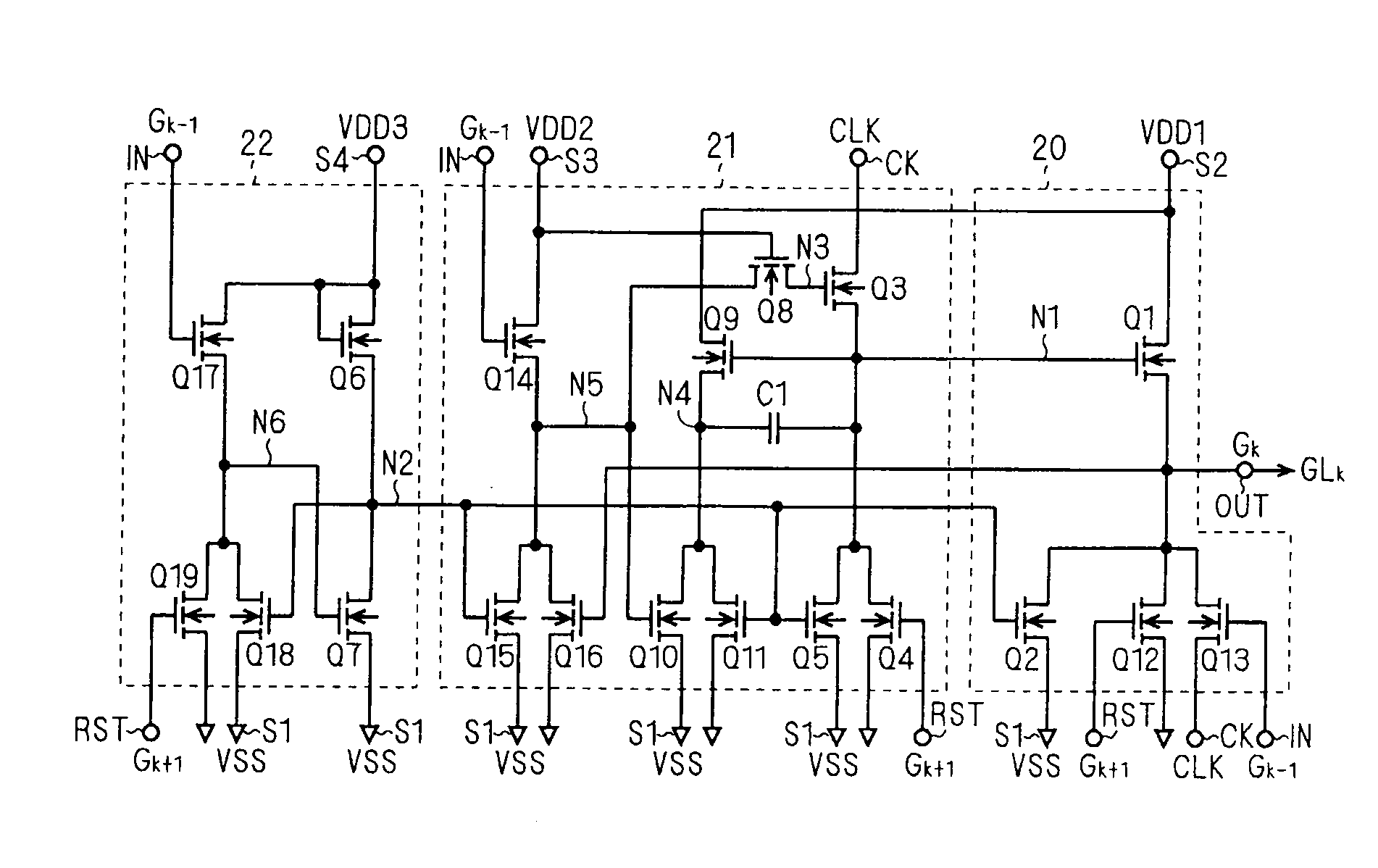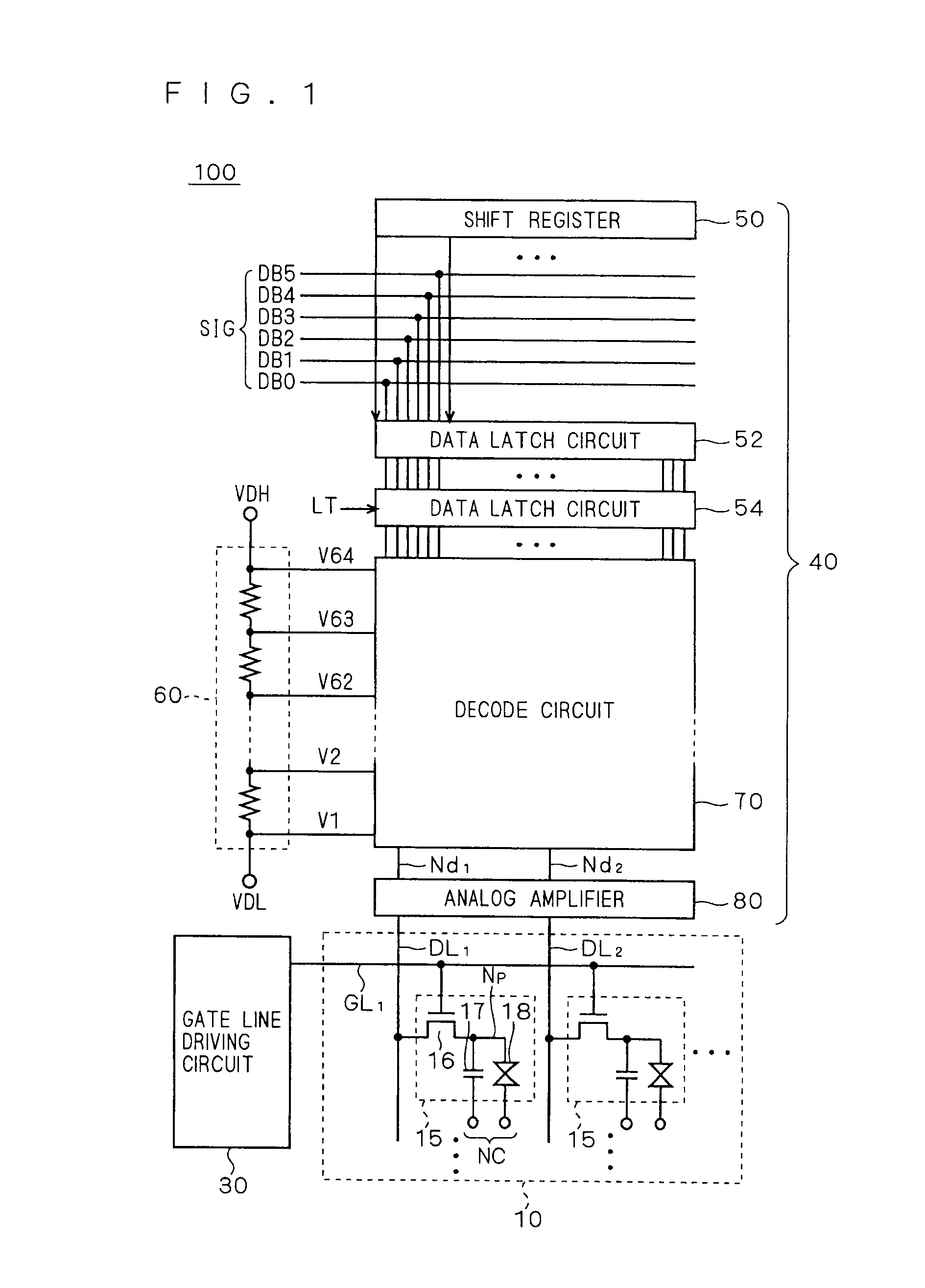Shift register circuit
a technology of shift register and shift register, which is applied in the direction of static storage, digital storage, instruments, etc., can solve the problems of increasing power consumption, and achieve the effect of high driving capacity and low power consumption of clock signals
- Summary
- Abstract
- Description
- Claims
- Application Information
AI Technical Summary
Benefits of technology
Problems solved by technology
Method used
Image
Examples
first embodiment
[0050]FIG. 1 is a schematic block diagram showing a configuration of a display apparatus according to the first embodiment of the present invention. In FIG. 1, an entire configuration of a liquid crystal display apparatus 100 is shown as a representative example of the display apparatus. It should be noted that a gate line driving circuit according to the present invention is not limited to application to a liquid crystal display apparatus, and can be widely applied to electro-optic apparatuses such as electroluminescence (EL), organic EL, plasma display, electronic paper, and image sensor.
[0051]The liquid crystal display apparatus 100 includes a liquid crystal array unit 10, a gate line driving circuit (scanning line driving circuit) 30, and a source driver 40. As will be clear from the following description, a shift register according to the embodiments of the present invention is arranged in the gate line driving circuit 30.
[0052]The liquid crystal array unit 10 includes a plural...
second embodiment
[0186]FIG. 11 is a circuit diagram showing a configuration of a unit shift register according to the second embodiment. As shown in FIG. 11, in the present embodiment, a voltage generating circuit 33 for providing a predetermined potential VDD5 to the drain of the transistor Q9 is connected to the unit shift register SR according to the first embodiment (FIG. 3).
[0187]The voltage generating circuit 33 has a fifth power supply terminal S5 that is supplied with a high power supply potential VDD4, a voltage output terminal VT that outputs the potential VDD5, and at least one clock input terminal with which a predetermined clock signal is input (FIG. 11 shows a clock input terminal CKT as a representative example). In the present embodiment, one of the multi-phase clock signals that drive the plurality of cascade-connected unit shift register circuits SR (i.e., the gate line driving circuit 30) is used as the clock signal input to the clock input terminal (FIG. 11 shows a clock signal C...
third embodiment
[0233]FIG. 16 is a circuit diagram showing the unit shift register SRk according to the third embodiment. Compared with the unit shift register SRk of FIG. 10, this unit shift register SRk is configured such that the drain of the transistor Q9 is connected to the voltage generating circuit 33 explained in the second embodiment.
[0234]In the unit shift register SRk of FIG. 16, the gate (node N1A) of the transistor Q9 is separated from the node N1 having a large parasitic capacitance. Compared with the capacitive element C1A, the parasitic capacitance of the node N1A is so small that it can almost be disregarded. Accordingly, when the level of the node N4 increases, the node N1A is increased to approximately VDD+VDD5. Therefore, the transistor Q9 operates in non-saturation region to rapidly charge the node N4 to the potential VDD5.
[0235]As a result, the potential at the node N1 is rapidly increased by the capacitive element C1, and the raised level of the node N1 is higher than that of...
PUM
 Login to View More
Login to View More Abstract
Description
Claims
Application Information
 Login to View More
Login to View More - R&D
- Intellectual Property
- Life Sciences
- Materials
- Tech Scout
- Unparalleled Data Quality
- Higher Quality Content
- 60% Fewer Hallucinations
Browse by: Latest US Patents, China's latest patents, Technical Efficacy Thesaurus, Application Domain, Technology Topic, Popular Technical Reports.
© 2025 PatSnap. All rights reserved.Legal|Privacy policy|Modern Slavery Act Transparency Statement|Sitemap|About US| Contact US: help@patsnap.com



